The folkloric costumes of the Jazira region… a record preserves heritage from vanish
Folkloric costumes are a record preserving the society’s customs and its social, economic, and cultural heritage, as we can say that it is similar to a mirror reflecting a long period of development through successive phases.
That is why the (Bayt al-Jazira – Mala Cizîrê – ܒܝܬܐ ܕܓܖܪܬܐ) project appeared to be interested in these costumes because of their role in highlighting the large cultural heritage of the population of the region such as the Kurds, Arabs, Syriacs and Yazidis.
The team of the project started its activities by visiting the village of (Tolko) in the countryside of the city of al-Hasakah, where the team got acquainted with the traditional costumes of the Yazidis after a lengthy meeting with the designer (Halima Jendo) who talked about the history of this costume.
Each age group has a distinctive dress. The youth wears clothes that differ from the elderly. In terms of color, the girls often wear the white color, where they rely on designs inspired by the white pigeon (Metani), as it is one of the peace symbols, Jendo said.
The Traditional Costume Week included several visits and sessions during which the team was able to get acquainted with the types of the folkloric costumes in general, their colors, times of wearing, their connotations and historical symbolism, especially during the visit organized by the team to a number of people interested in Kurdish costumes such as (Zarka Umm Zakaria) from the al-Nasirah neighborhood in al-Hasakah.
“Every occasion has a costume that can be distinguished from the other. For example, during funerals and sorrow we can notice costumes different from those that are worn during other occasions, as they are of dark, non-bright colors, and devoid of jewelry, while we see the opposite in the other events and parties, where the colors are shiny and inspired by the colors of spring with various jewelry,” Umm Zakaria said.
As for the clothes special for (the night of henna), (Êvara Hinê) in Kurdish and (حينو – ܚܝܢܐ) in Syriac, Kurdish girls resort to wearing the attractive bejeweled red color costumes with new designs.
The team of the coordinators and volunteers also paid a special visit to the (Shamiram) workshop for the Syriac-Assyrian folk costumes in the al-Wusta neighborhood in the city of (Qamishli/Qamishlo/ ܙܐܠܝܢ).
They became acquainted with the designs of the Syriac-Assyrian costumes that differ from other costumes of the population of the Jazira region, whether in terms of colors, designs, connotations, symbolism, patterns of its ancient social hierarchy, and the occasions to wear them such as (Akito – ܐܟܝܬܐ), known as the Assyrian Babylonian New Year, especially the (Khumala) which is most prevalent among women and consists of the long dress (sodra – ܨܘܕܪܐ), the chest (sanjak – ܣܢܓܩ), the belt (kumara – ܟܘܡܐܪܐ), the hat (boushia – ܒܘܫܝܐ), and the dance piece (yalkhata – ܝܐܠܟܬܐ).
For example, the costumes of the (Kings/ ܡܠܟܐ) are distinguished from the those of the public by their distinctive addition, such as the scepter, the crown, and the distinctive ornaments. While the queen’s costume is distinguished by its length that reaches the ground, the shawl that is engraved with golden strings and (the chamomile/ ܒܝܒܘܢ) flower inspired by the Assyrian heritage.
The authentic Arab costume had its share in the Folkloric Costume Week, as this was evidenced by the visit of the team to the designer, (Tahani al-Dakhil’s) house in al-Kallasah neighborhood in al-Hasakah.
Al-Dakhil noted to the historical details related to the traditional Arab costumes, their connotations and their colors, as part of the ancient customs and traditions, for example the (keffiyeh’s) knot or putting the cloak on the shoulder is an indication of a request that needs to be met.
Because culture is considered a whole of society’s heritage of the arts, ideas, and historical events in addition to food, clothing and other things, folkloric costumes in this sense, become one of the indicators of the culture of each society, whether through designs, prevailing colors or knitting methods for different wearing occasions, or even through climate-related circumstances, and the simple and complex details of everyday life.
The (Bayt al-Jazira – Mala Cizîrê – ܒܝܬܐ ܕܓܖܪܬܐ) project launched by the (GAV) organization at the beginning of last August, is an attempt to celebrate and promote cultural differences as a fundamental pillar in building and preserving civil peace and sustainable coexistence, and enhancing societal cohesion factors through deepening knowledge of the communities with each other and opening unconventional channels of communication among them.

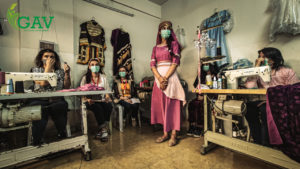
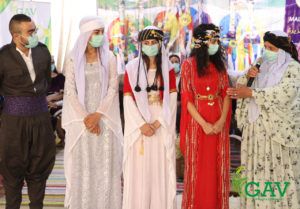
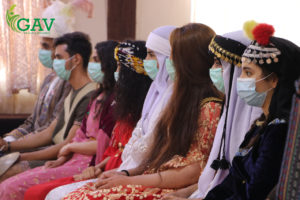
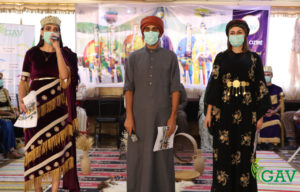
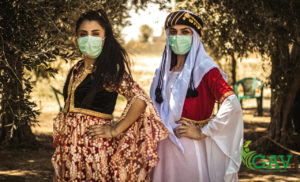
نوعان من أزياء الفتيات الإيزيديات خلال أسبوع الألبسة التراثية – GAV

